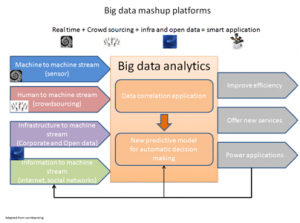More and more people in the world use cell phones or smartphones: 6 billion mobile phones are used on a regular basis on earth, and this number is increasing. Of those six billion phones, five billions are in developing countries. We could say that nearly everybody has a cell phone and uses it. Today, most of them are cheap phones that can do little besides making calls and sending text messages, but in the near future, smart phones will become the standard for communication. Using phone infrastructure (from basic or smartphone one), which is widely spread in all the countries (even in developing countries), to gather data in order to provide services to the population is a promising way, especially in those poor countries generally lacking data-gathering infrastructure. Here are two examples: The first one creates disease-fighting tools leveraging cell-phone mobility data. Caroline Buckee and al. from Harvard University is using mobility data from cell-phone (geo localization and timestamp data of each call) to gather detailed information about human travel pattern in one region. From the analysis of these big data (15 millions cell-phone in real-time), she built predictive model about population movements and spread of disease, in this case malaria. It is a typical use case of big data today, i.e.: using machine to machine stream to understand patterns (data correlation application) and then, from these patterns, build new predictive model for automatic decision making (see diagram below):
The results are two-folds:- The predictive model of malaria spreading helps local authorities to focus their preventive campaigns (e.g. bed netting) on the right areas and population (most vulnerable)
- Using real-time analysis of mobile phone call and predictive model about population movements enables to send SMS messages to the travelers to warn them about the dangers and inform them about safe procedures they can follow to protect themselves from the disease. These warning campaigns could also rely in the future on other additional data coming from weather forecast and satellite images which could be useful to understand better mosquitos’ behavior and will be included into the predictive model.

 English | EN
English | EN 

